
The campsite in Hirtshals is only about ten minutes from the port and so we have no issue arriving on time.
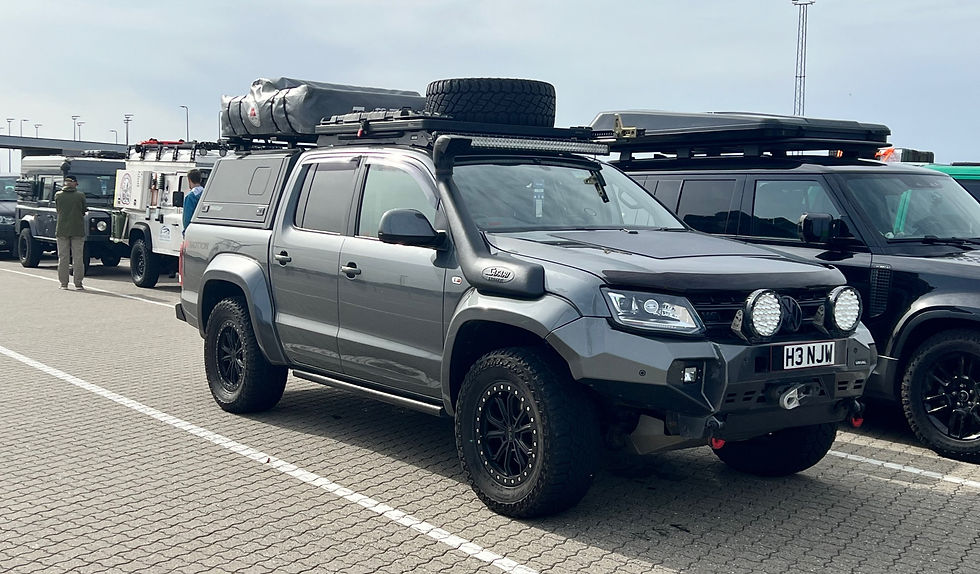
During the wait to board, people wander about looking at the vast array of vehicles headed for Iceland, it's a bit like a car rally!

Our cabin is very similar to the ones we had on the Santander Brittany ferries - fairly basic, but comfortable. We've been tipped off that food and drink onboard are really expensive and so like most other passengers, we've brought a kettle and supplies with us although we have splashed out and ordered dinner on one of the nights.

The ferry is larger than any we've been on before and the journey is billed as a mini cruise. Certainly the lounges, cafes and restaurants are really nice and there are old fashioned, wooden steamer chairs on deck.

Our favourite place is the bar and lounge with panoramic views on the tenth floor where we make it our business to sample the beer........
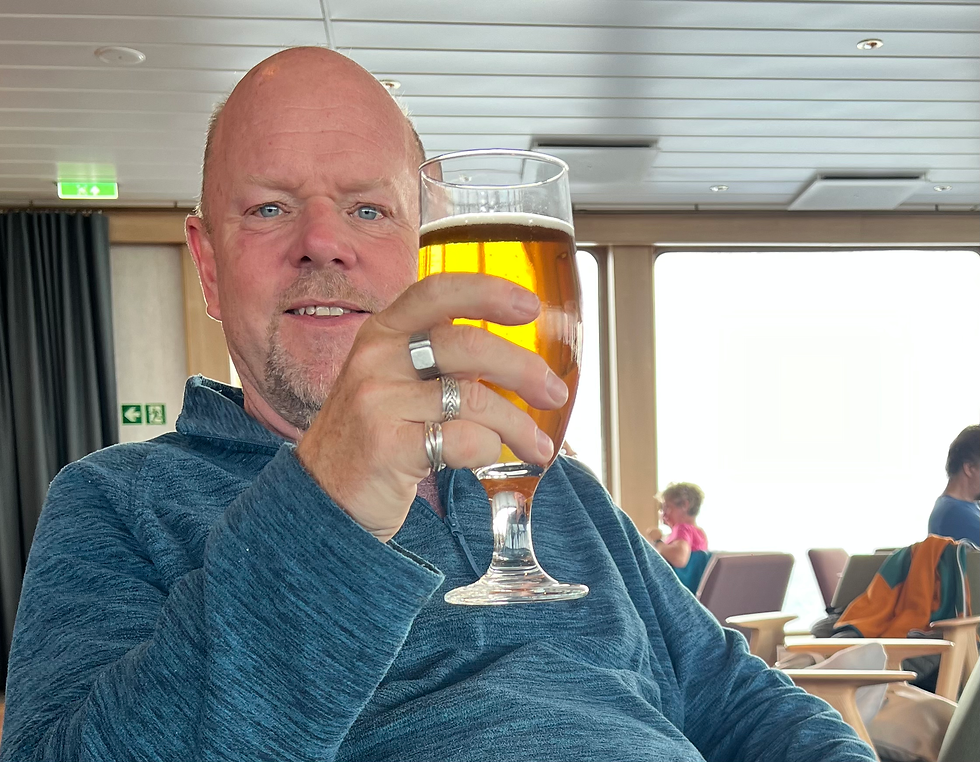
.....and the chaise longes.
It's very peaceful in this bar and we along with most of the other passengers there fall fast asleep - let's hope we didn't snore!
We mentioned in our last blog that the ship boasts hot tubs. We didn't avail ourselves of this facility on the basis that we always refer to the water in such things as 'human soup' which rather kills the romance and also on the basis of the outrageous cost.

The duty free shop has all the usual products for sale but to our surprise there's a whole section devoted to knitting and we see lots of passengers knitting, it's a big thing apparently.

We stop off at Torshavn, the only port in the Faroe Islands able to accommodate ships as large as ours. The weather is grim which never helps and although the town doesn't look very exciting it does have some interesting and attractive buildings on the harbourside, they have living turf roofs.
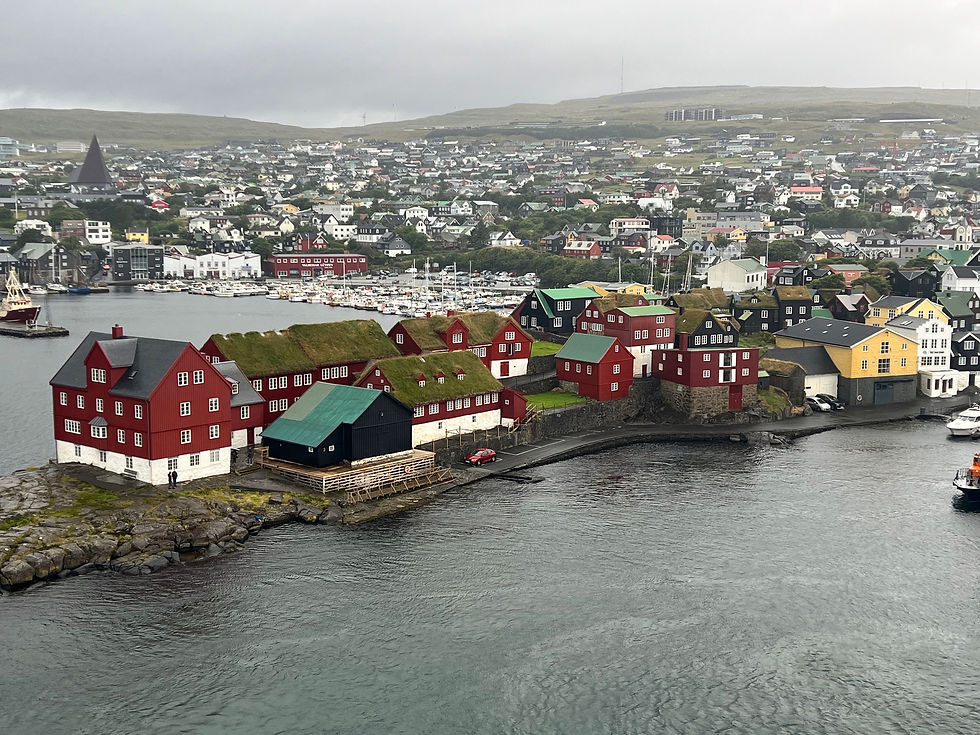
We have been told that the passage out of Torshavn is very dramatic and even though the weather is so nasty we can't help but be impressed. The massive ferry glides out via a narrow channel between two islands, it's quite a thing to see and something even the weather can't put a damper on.
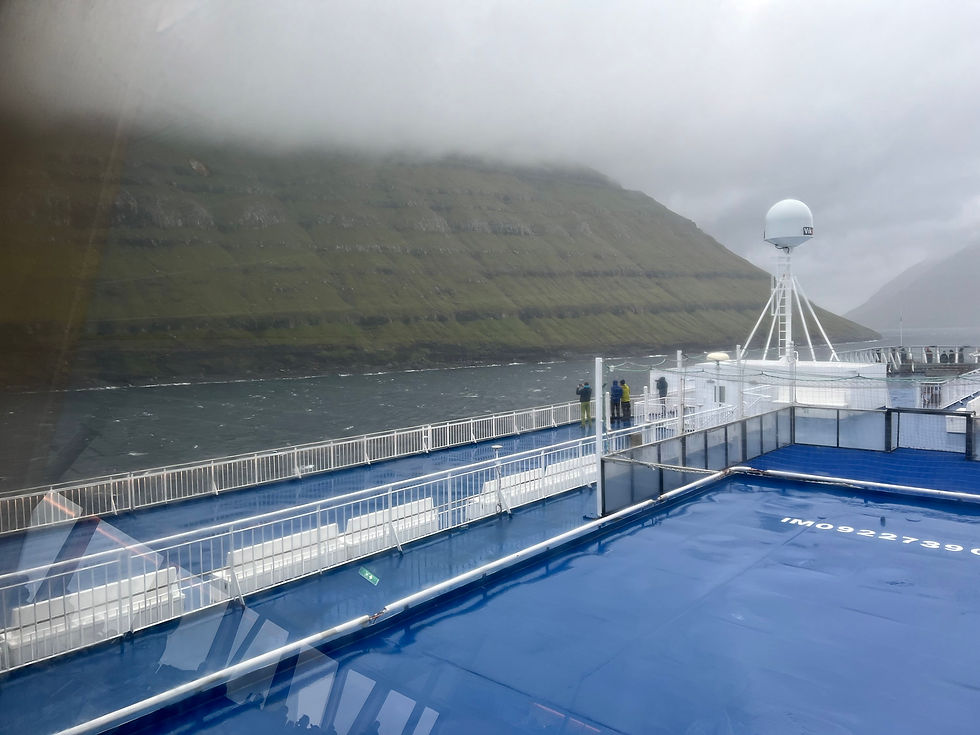
There are a couple of lectures on board that we decide to go to which give us some really interesting information about the Faroes and Iceland. We also take advantage of the fact that there's a library onboard to do some final research and planning.
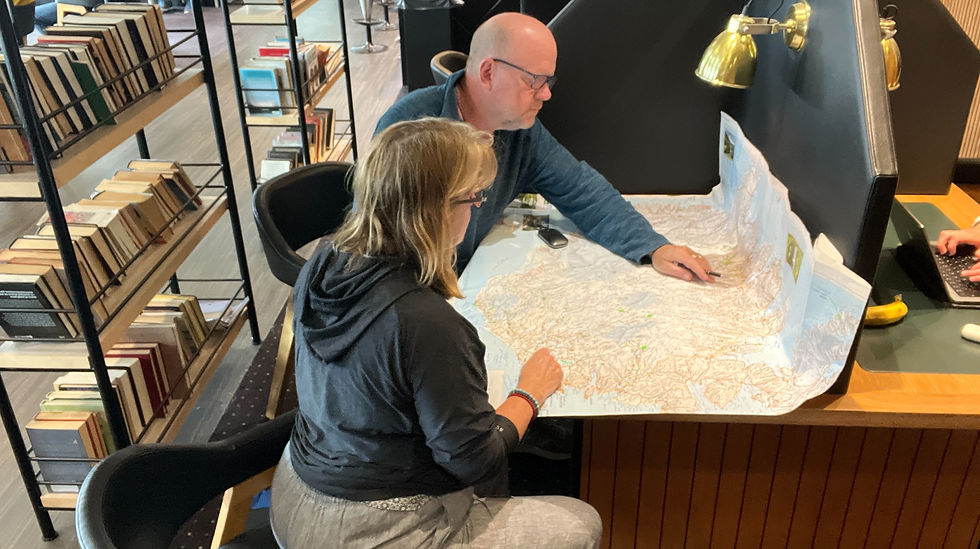
We are going to dock at Iceland's port of Seydisfjordur first thing in the morning and so everyone has to be up bright and early and a good job too as the views on the approach are fantastic. The weather is cold but sunny enabling Iceland to show off its assets to very best advantage.
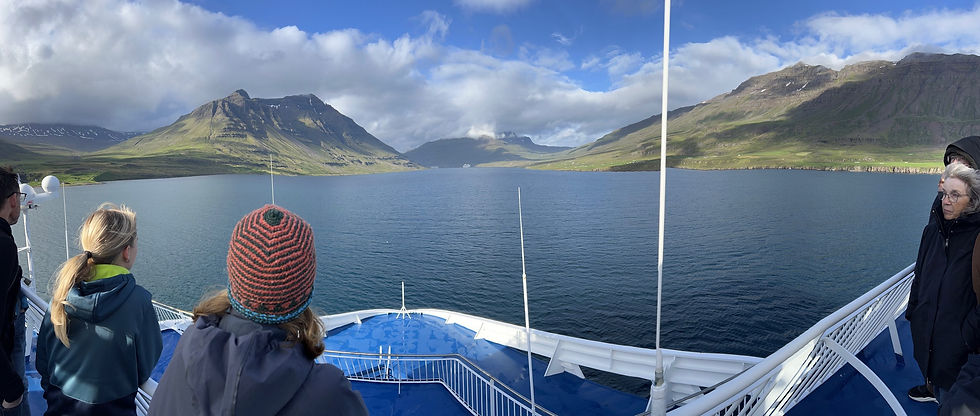
As we draw into port we see that there are a couple of cruise ships at anchor and their tenders are buzzing backwards and forwards ferrying guests to waiting coaches to whisk them off on whistlestop tours.

We have read that the port town is worth a look and we have a wander round and get some cash out however as it was early, pretty much everything was closed!

We encounter a couple of Brits, the first we've seen since leaving Jo and Dave in the Netherlands!

Seydisfjordur is in the east of Iceland and we are heading into the centre and then north. We stop at a viewpoint in an evelvated position and have a cuppa while we take in the view which really is wonderful. Although it's sunny it is cold... only about 6 degrees. Our research had told us that in August it should be up around 16 - 17 degrees! We decided to stop off at the next town to get some thermal base layers, now we hope we're all set!


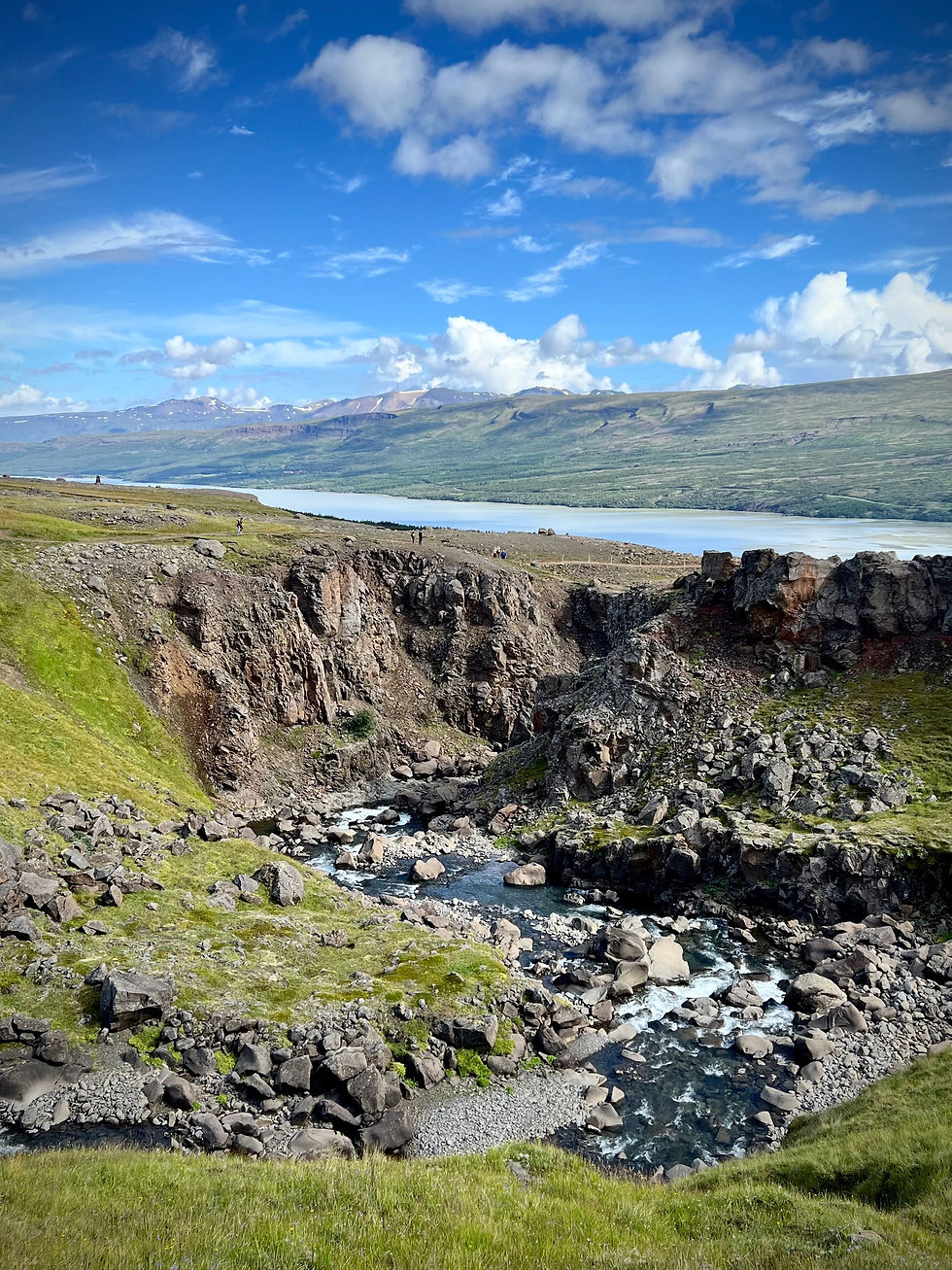
Our first stop is Hengifoss, a waterfall we want to see because of the unusual rock strata. This is the third highest waterfall in Iceland, the water drops a dizzying 128 metres (420 feet). The red strata are veins of clay sandwiched between basaltic layers.
Our plan is to head into the Highlands, the remote interior of Iceland. Our route will take us on F Roads, only accessible by four wheel drive vehicles - Rocky is just the job! We will camp in this area tonight but we don't yet know where, we'll play it by ear.
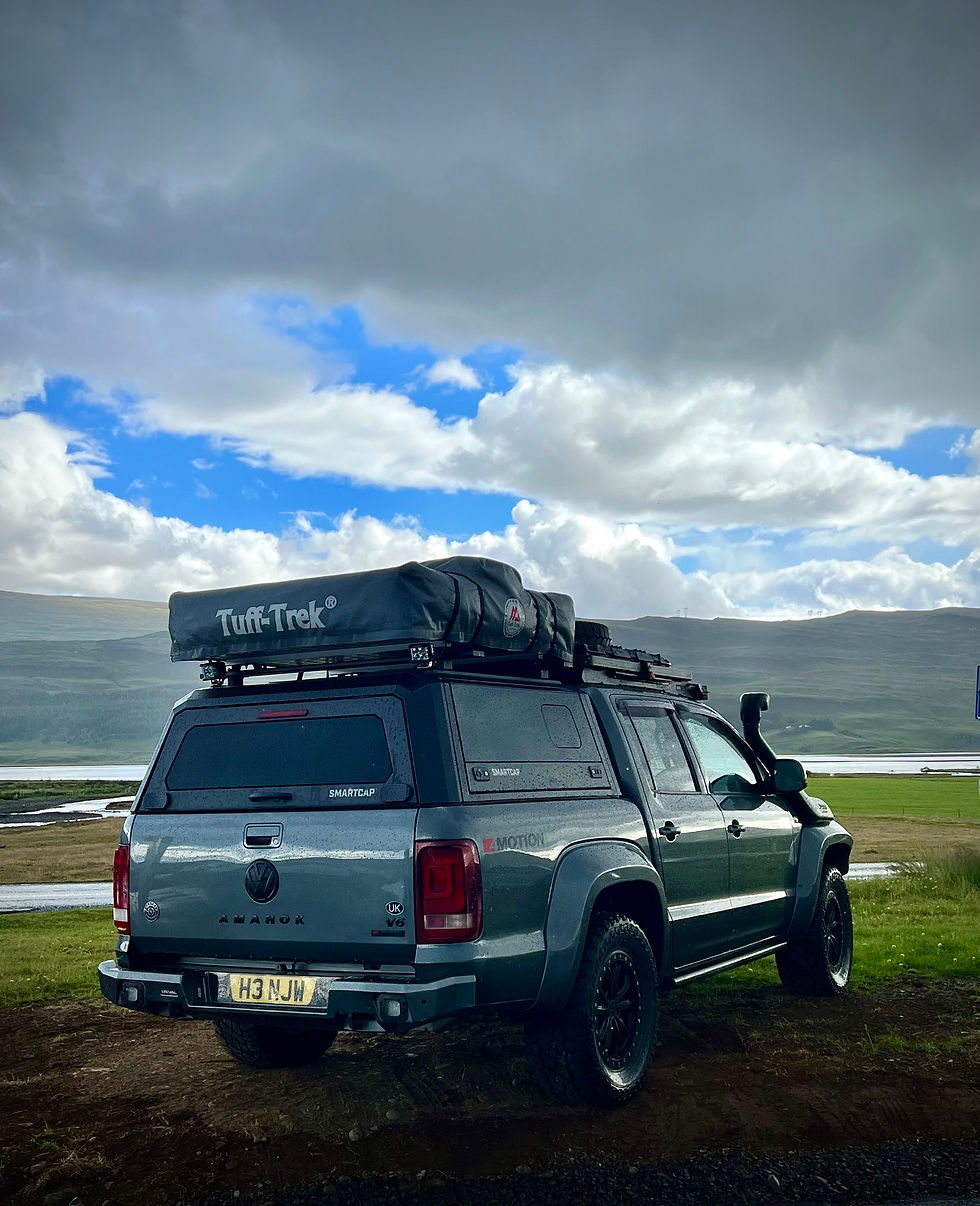

We don't see any other vehicles for the entire journey of a couple of hours. Nick takes the opportunity to take some drone action shots of Rocky - of course while driving at the same time!
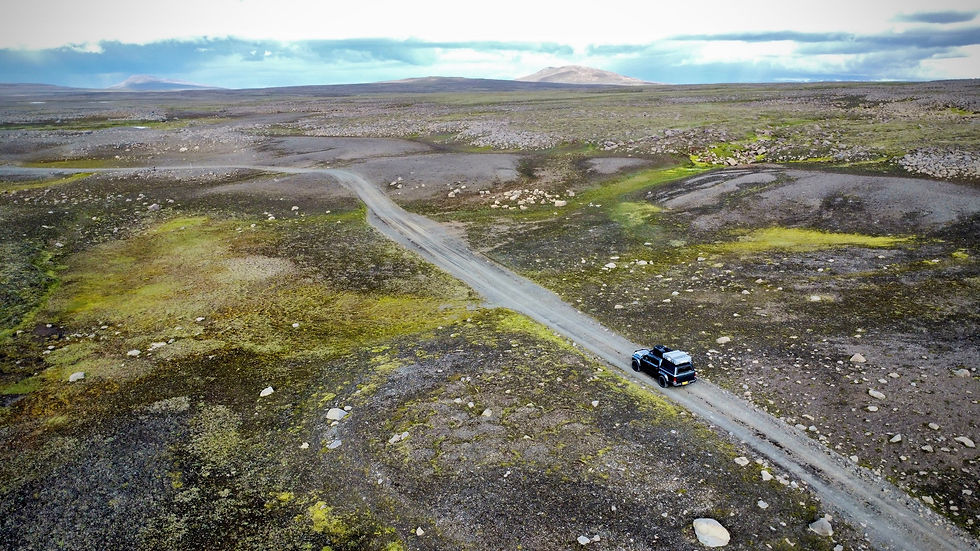
We encounter our first river crossing and Rocky takes it in his stride.

This is really remote territory, there is no sign or sound of human life at all, just a few sheep to keep us company. The funny thing about the sheep is that they all look as if they recently visited the hairdresser, their fleeces look immaculate, not a tangle in sight!
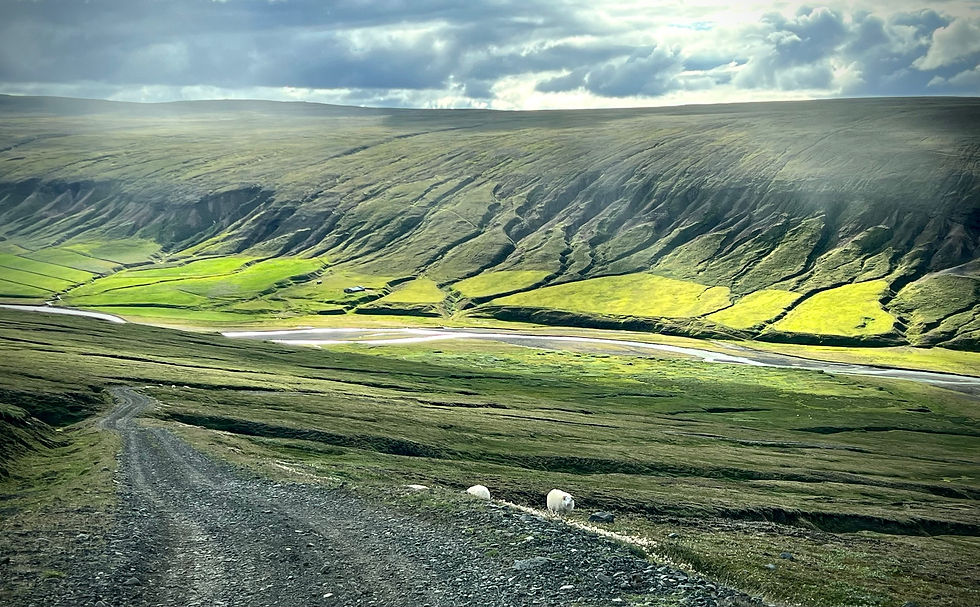
We bowl along enjoying the sunshine but then........the clouds gather, the heavens open and our hearts sink. The next river crossing is much deeper, not helped by the sudden heavy downpour but good old Rocky does just fine once more.
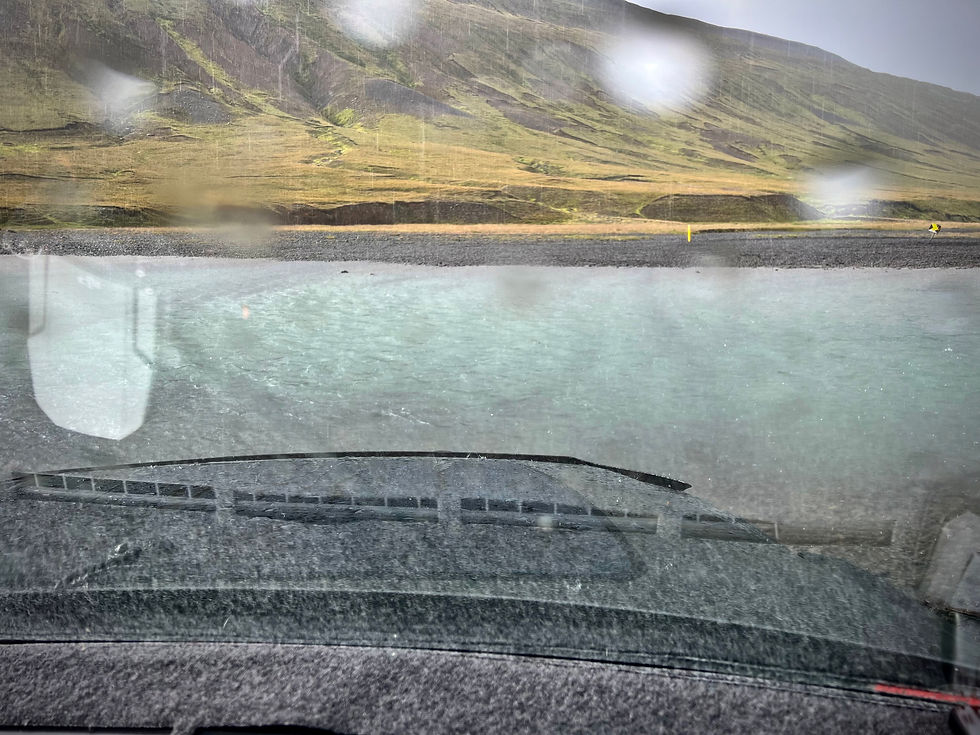
We find an incredible place to spend the night and as we arrive the weather improves, a good omen we think.

This is an amazing place, a reconstructed traditional timber frame farmstead with turf roof.

We go over to the farmhouse and find inside a cosy room heated by a log burner. We have hot chocolate and small panacakes which are delicious. The owners don't live at the property but rent out a small cottage and campers can also stay there.
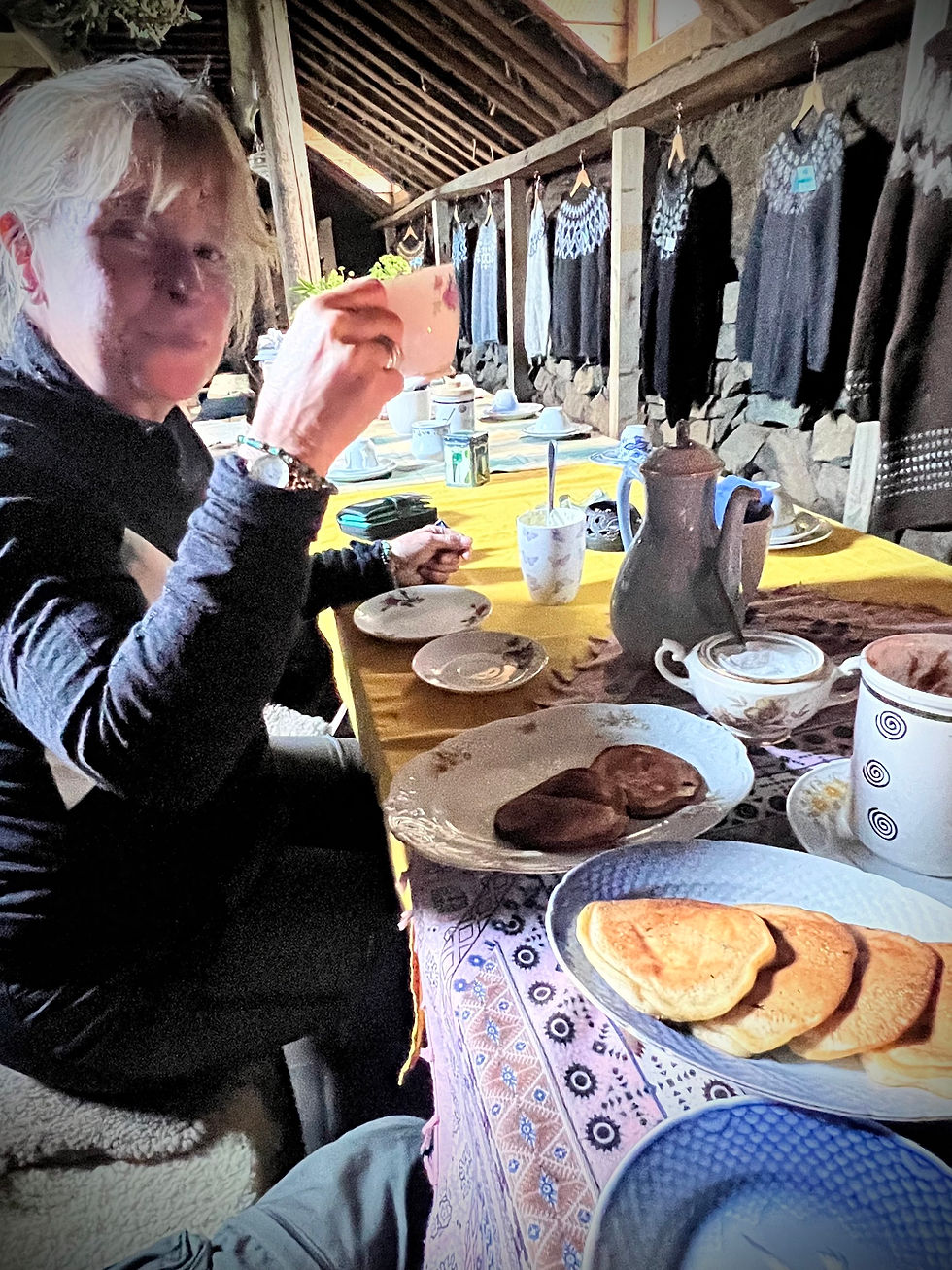

Facilities are very basic, loos and cold water and that's it but that's part of the charm; apart from wild camping in Morocco this is the most remote place we've stayed. One other couple do come to camp later on in the evening but it could easily have been us alone there after the owners went home. The remoteness and utter peace are wonderful, it's something that is difficult to find in this modern world where you can usually hear the distant rumble of traffic or planes even in really out of the way places.
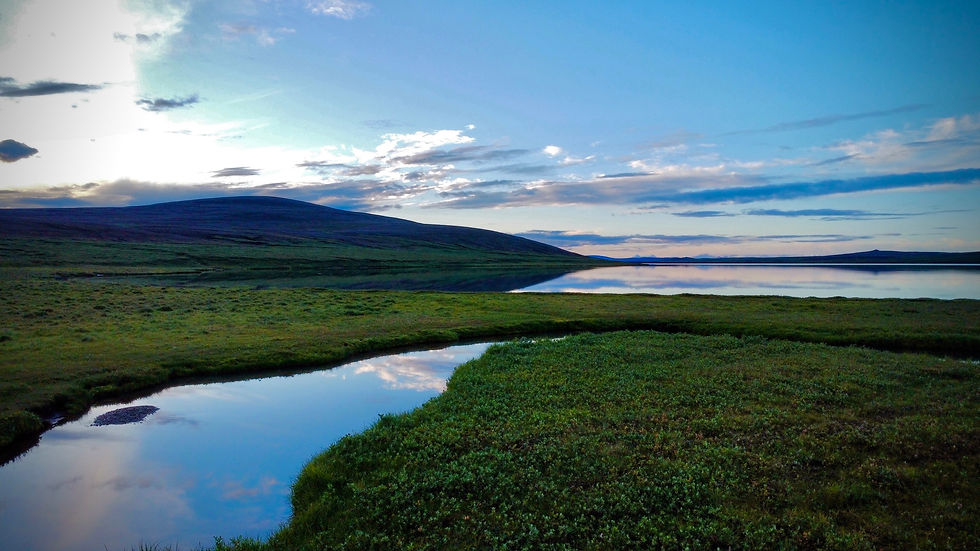
It is really cold once the sun starts to set but we have enough bedding to make our tent cosy and we sleep very well. In the dead of night we find the patter of rain soothing - not thinking of what it might mean in terms of our journey the next day.
The next morning it is still raining and it's very cold. We stay snuggled up in bed until there's a let up in the weather and we take advantage of it to pack up and head off. This isn't ideal as we've had to pack the tent up wet but there isn't any choice.
We made the right call as the rain soon returns and really sets in.
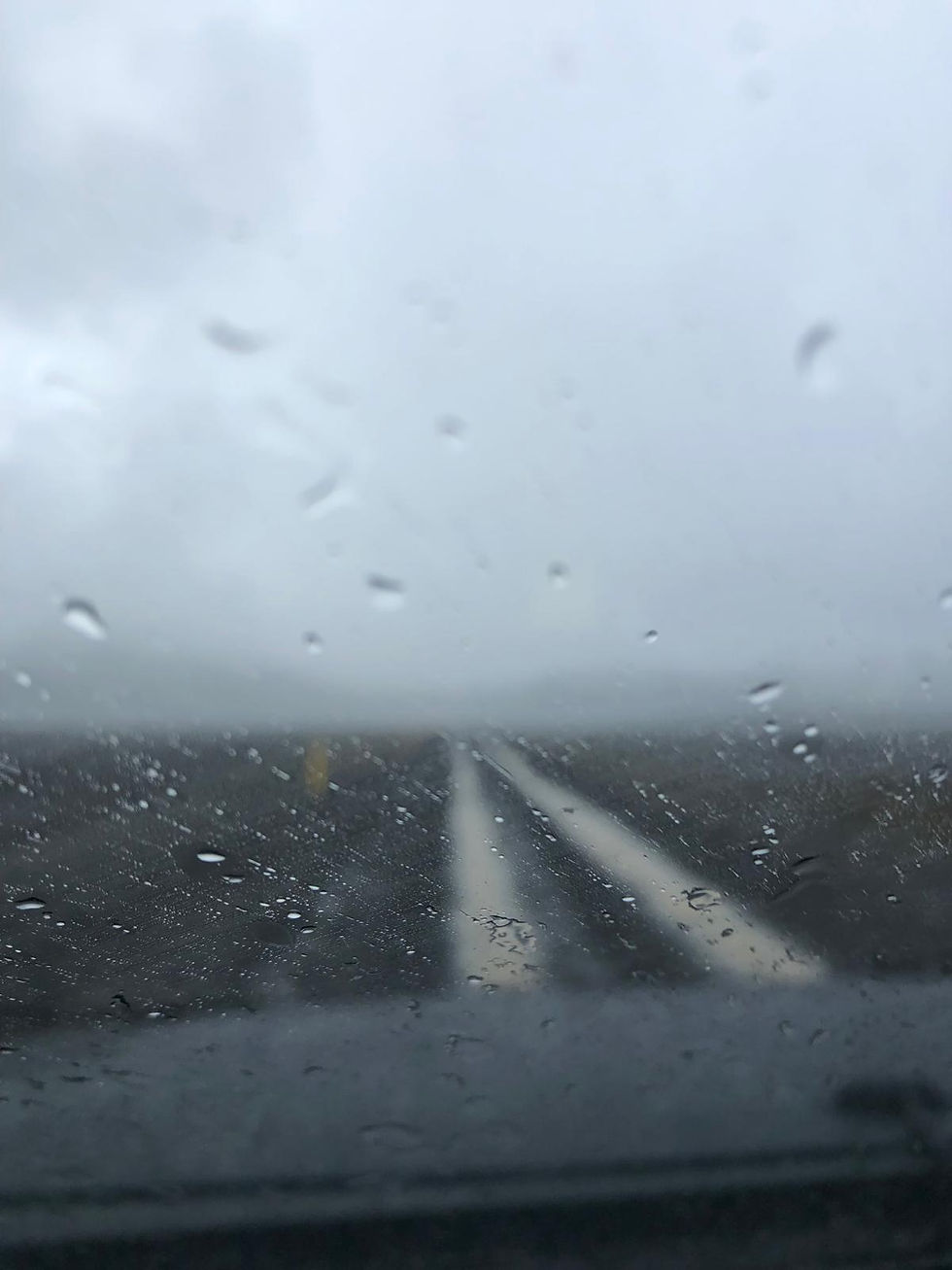
Undeterred, we don our waterproofs and warm clothes and head out to see two magnificant waterfalls, Dettifoss and Selfoss.
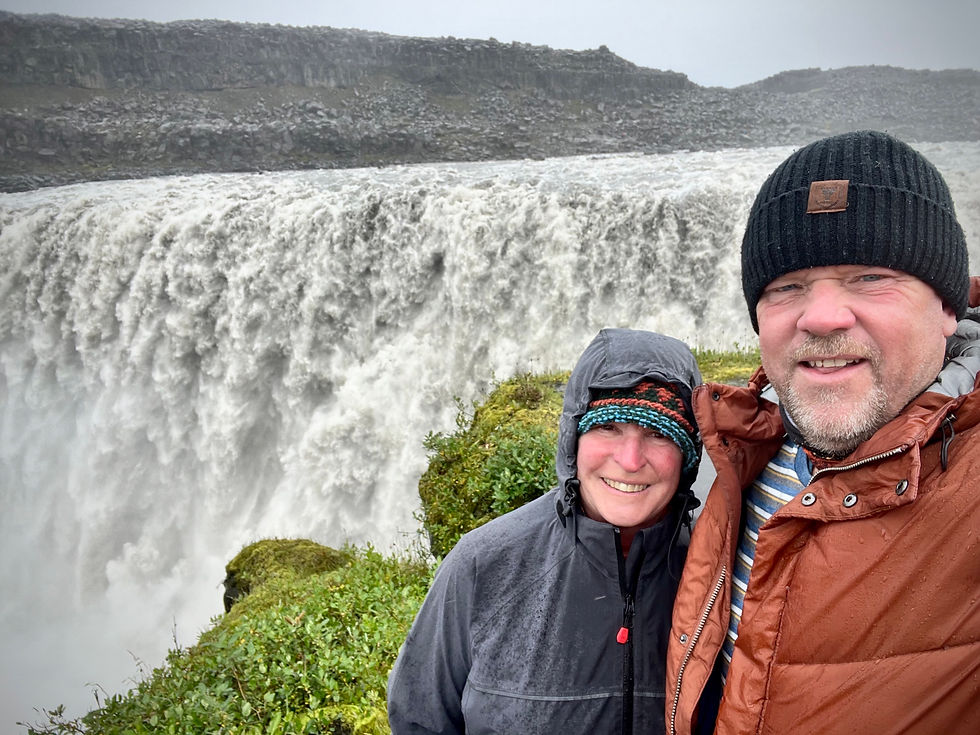
Dettifoss has an incredible amount of water cascading over it, it is the second most powerful waterfall in Europe. The falls are 100 metres wide with a drop of 44 metres, apparently the rate of water flow is enough to fill an Olympic-sized swimming pool in two seconds, looking at it it's easy to believe.
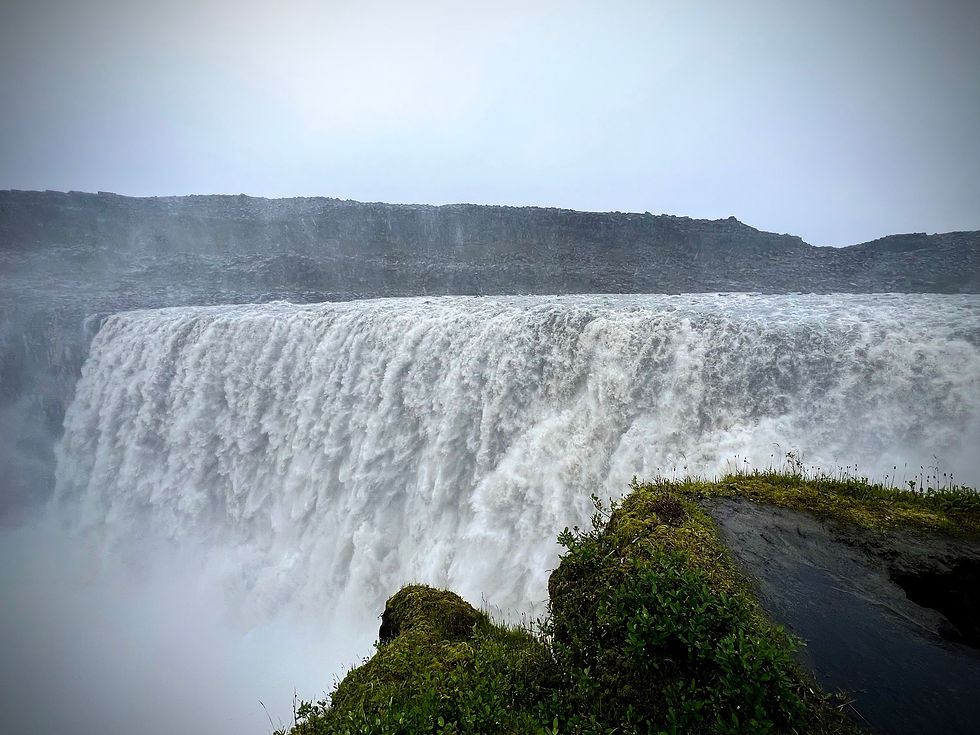
Selfoss is a different beast, it's wider than Dettifoss and the water flows over the edge at a variety of points rather than in one rush. By this time we are really wet both from the spray from the waterfalls and from the relentless, driving rain. It's a bit miserable if we're honest but we are people on a mission with sights to see and we aren't going to be defeated by a bit of weather.
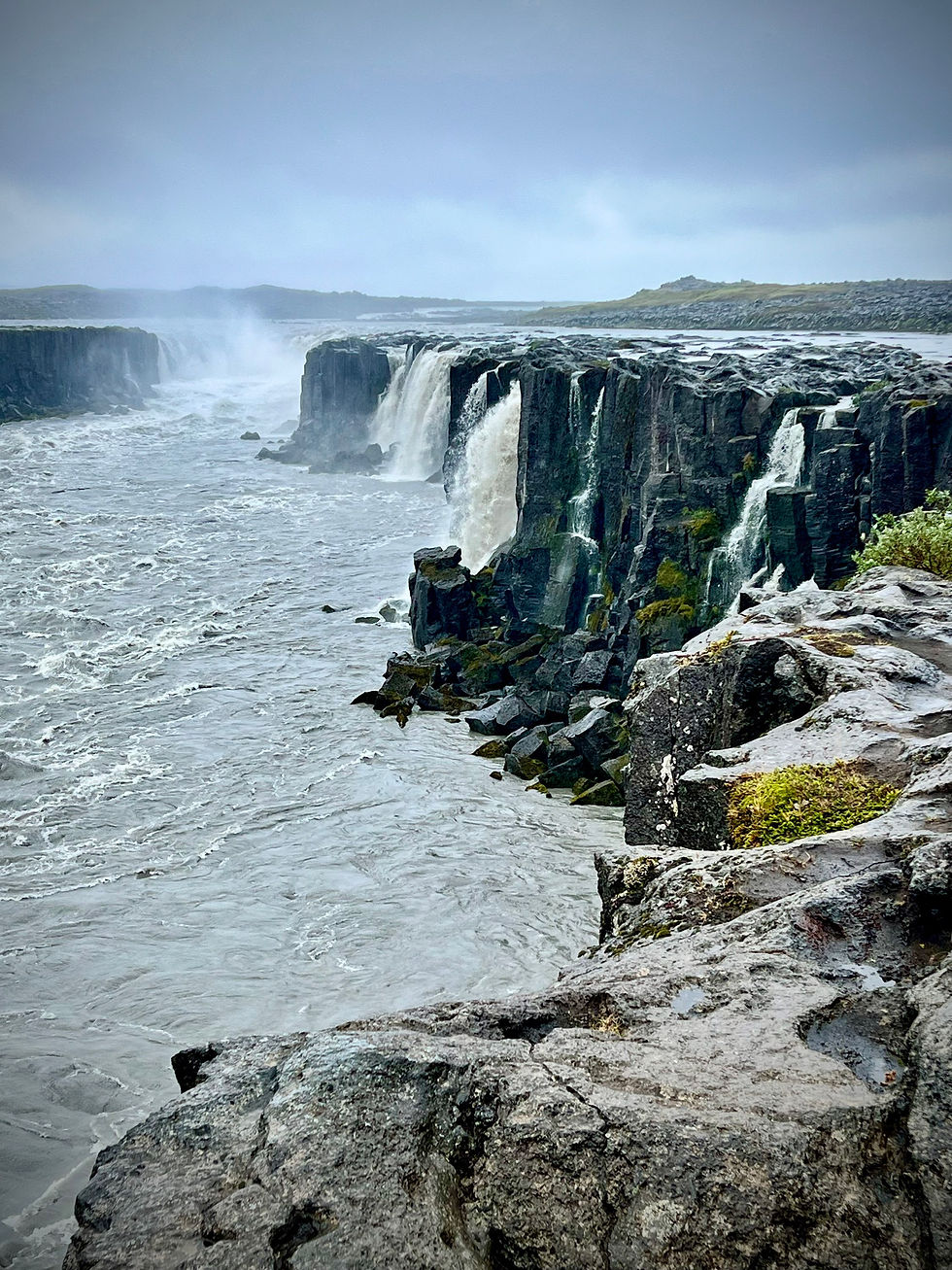
Back in Rocky and the navigation goes a bit awry. Nick starts to sigh and tut a bit and Janette has to look at him sternly over the top of her glasses.... it's time to stop sighing!

We eventually locate the F Road we need and set off towards Krafla......
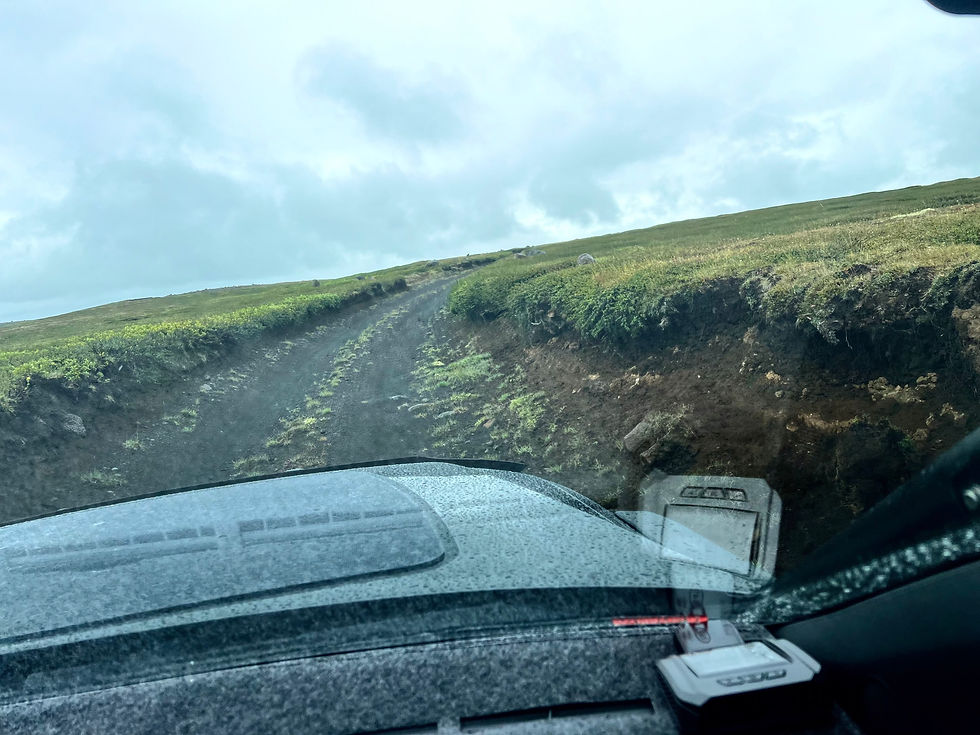
......on the way we see a stream with steam rising and stop to feel the temperature of the water - disappointingly tepid!

There's plenty more steam as we approach the Krafla Geothermal Power Plant. This has 33 boreholes and is able to produce 500 GWh of electricity annually. There is a definite whiff of sulphur (or rotten eggs) in the air!
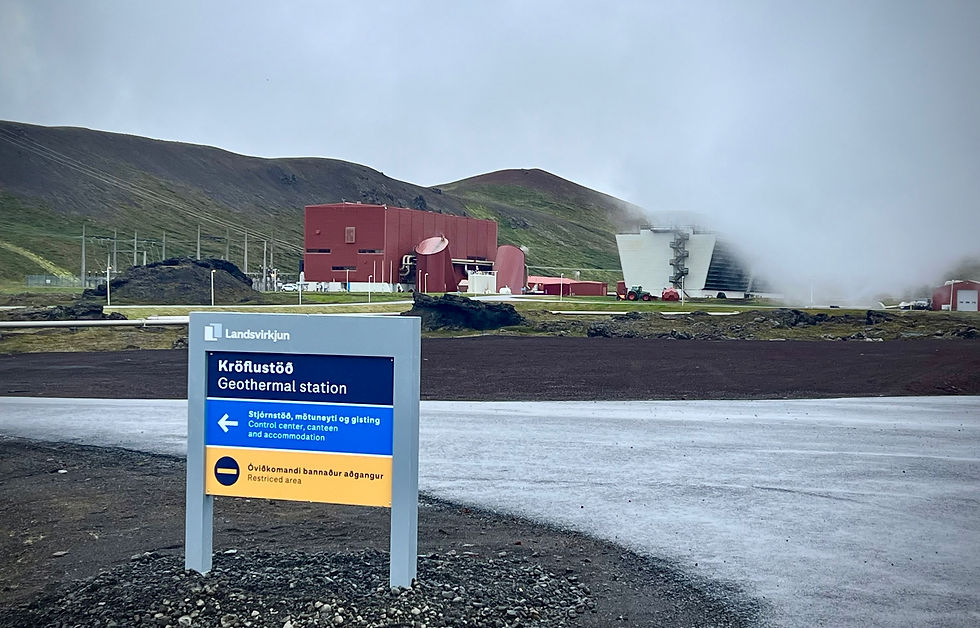
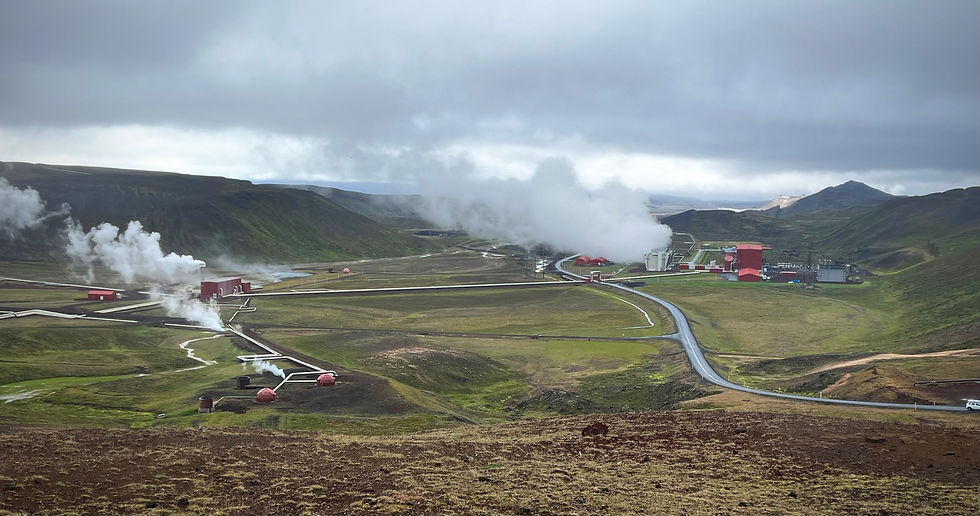
We reach our target, the Krafla Viti volcanic caldera - this is a cauldron-like hollow formed shortly after a volcanic erruption - and this one is 300 metres in diameter and 2 kilometres in depth and the water is a beautiful turquoise colour due to the bacteria present in the sulphur fields that surround it.

The road from Krafla to our next destination is lined with lava fields full of weirdly shaped lava deposits.
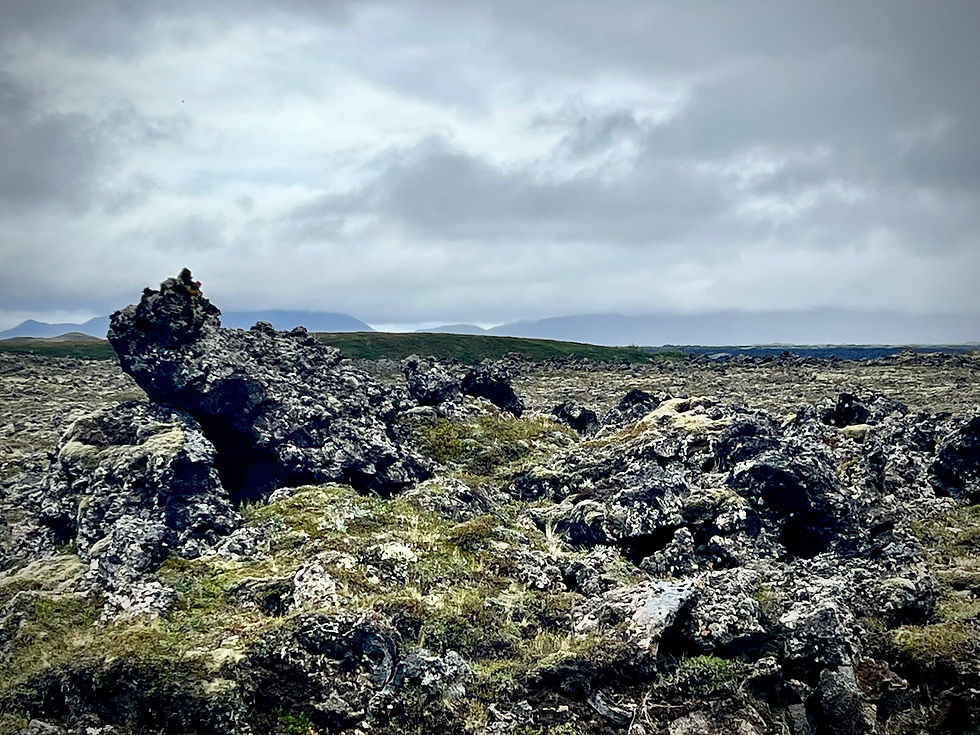
Next stop Namafjall also known as Hverir, a geothermal area with hot mud pots and smoking fumaroles surrounded by sulphur crystals.
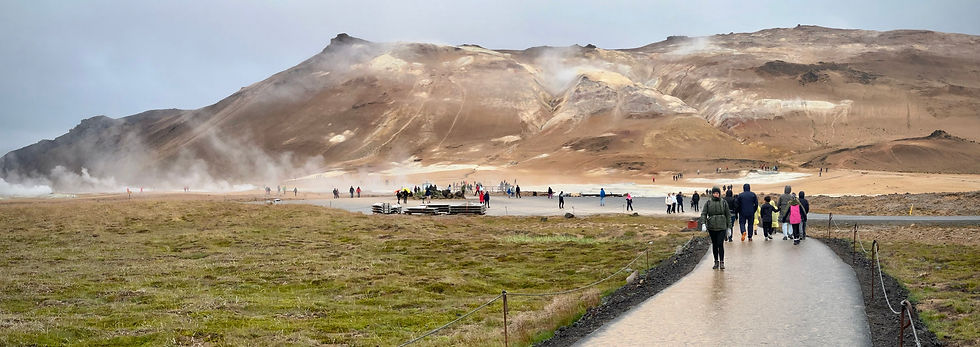
It's a bit touristy, but incredible to see. It’s a surreal other-worldly landscape where mud bubbles and gurgles and steam spits and hisses. The smell of sulphur is really strong!
It's really important that you stick to the marked paths as there's a danger that if you stray too near, the ground can give way landing you in the boiling mud which is not a good place to find yourself.
On a whim we decide to take a small detour from the main road and we're very glad we did as we stumble upon Lake Myvatn which is exceptionally beautiful, like a landscape out of Lord of the Rings The lake was created by a lava erruption 2,300 years ago and there are lava pillars sticking up out of the water and things called rootless cones which look like volcanic craters but don't actually vent lava.
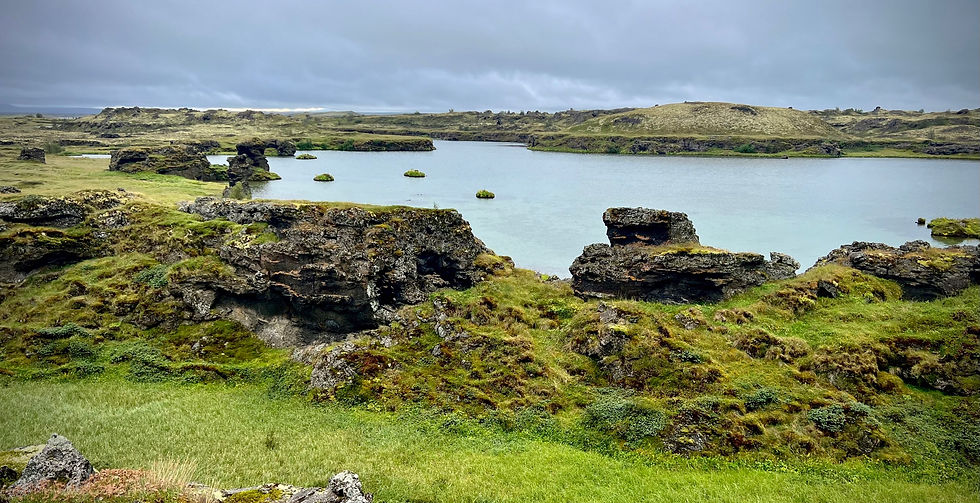

Final stop for the day, Godafoss waterfall which proves to be the most impressive waterfall we've seen so far, truly magnificent. Godafoss means 'waterfall of the gods', it has the reputation of being one of the most beautiful waterfalls in Iceland and we can easily believe that. It is 30 metres wide with a height of 12 metres so not the biggest but we think it's the horseshoe shape that makes it so picturesque.
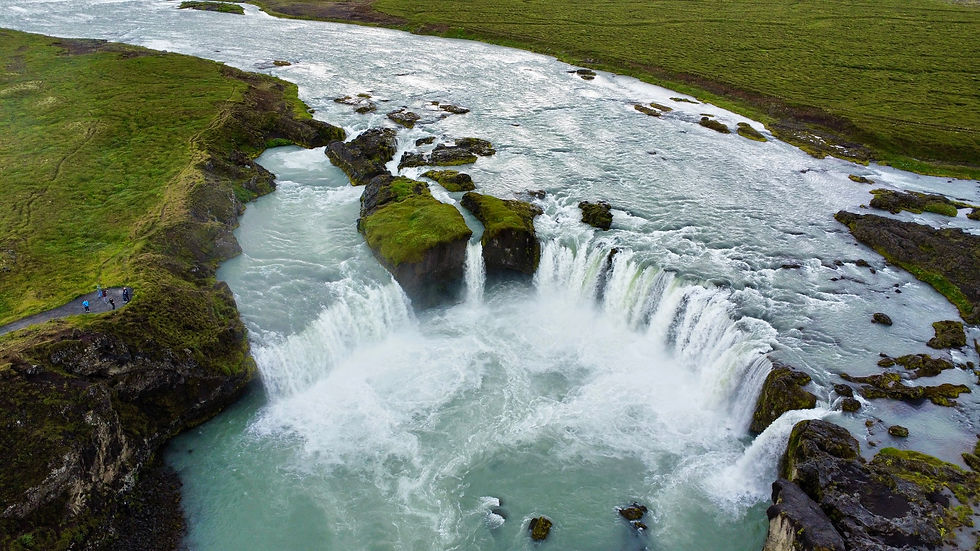

We end the day with soaked clothes, wet and muddy boots and the rain is still falling. We have no shelter apart from the tent which is still wet and the front seats of Rocky. The forecast is for more rain and even lower temperatues.
We've come equipped to deal with the cold, for camping and for roughing it off road. Due to space restrictions, we have a limited number of clothes, but are both kitted out well with hats, coats, gloves and walking boots for hiking. What we hadn't planned for was how to dry these items out effectively when they're absolutely saturated!
We're here to enjoy the experience, it doesn't have to be a feat of endurance so we decide to book into an apartment for a couple of nights to dry everything, do some much needed washing of pants and socks and to re-group.
This also gives us the opportunity to spend some time in Iceland's second city, known as the capital of the north - Akureyri.
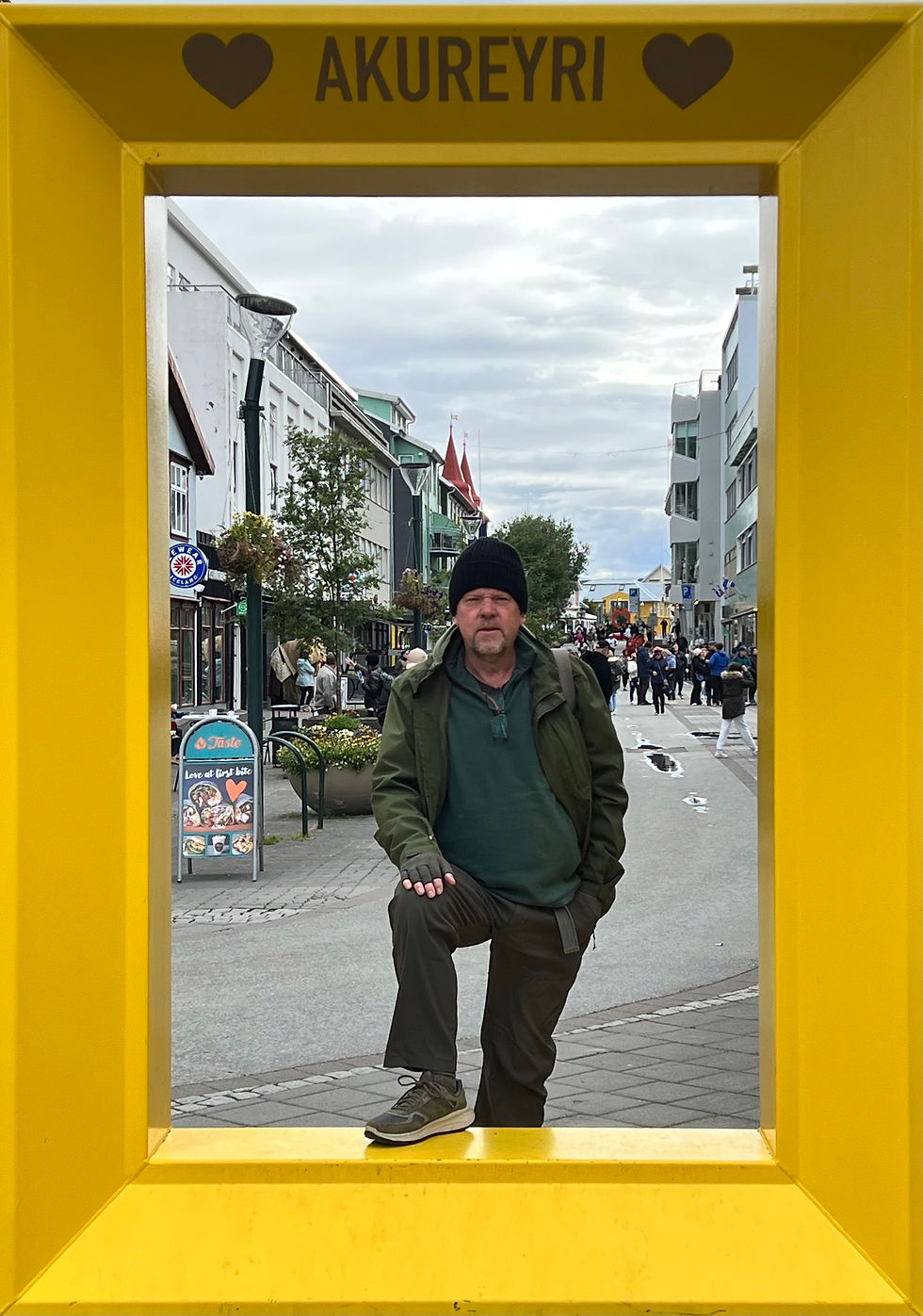
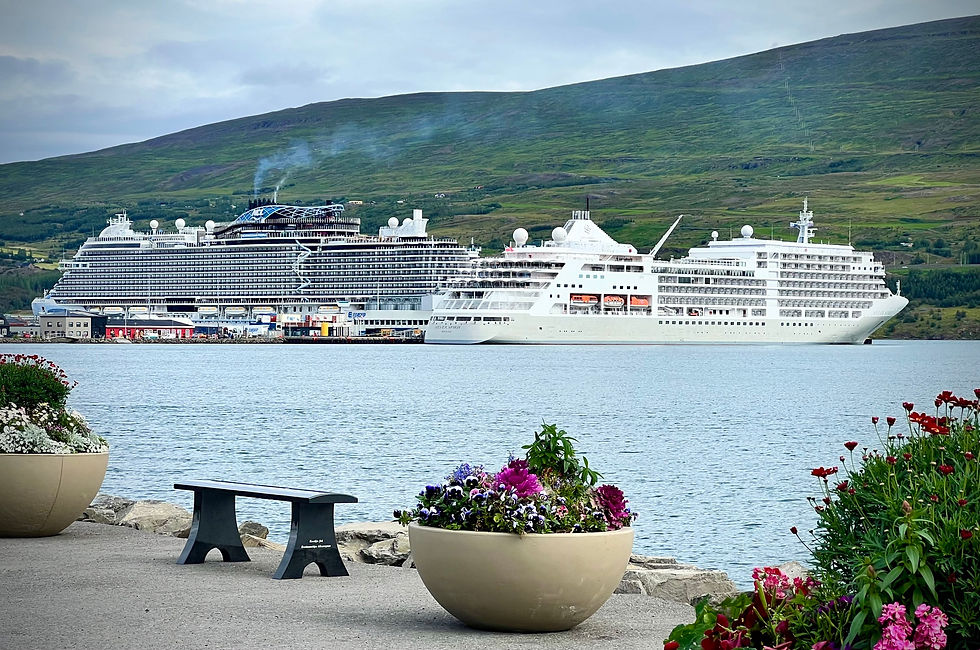
It is a pretty port city and fishing centre with the seemingly compulsory cruise ships in dock; they are so massive they dwarf the town. With a population of just 19,000 Akureyri would be considered a small town in the UK but here in this sparsely populated country this is a real metropolis.

Interestingly, in order to protect and preserve them, the old timber buildings were clad in corrugated iron sheets or slate tiles as well as some covered in metal sheets pressed into shapes of stone blocks - these pressed sheets were imported from the US in the 1930s.

The red traffic lights in Akureyri are heart-shaped. This apparently came about to raise spirits within the community when morale was low following the financial crash of 2008. It certainly brought a smile to our faces.
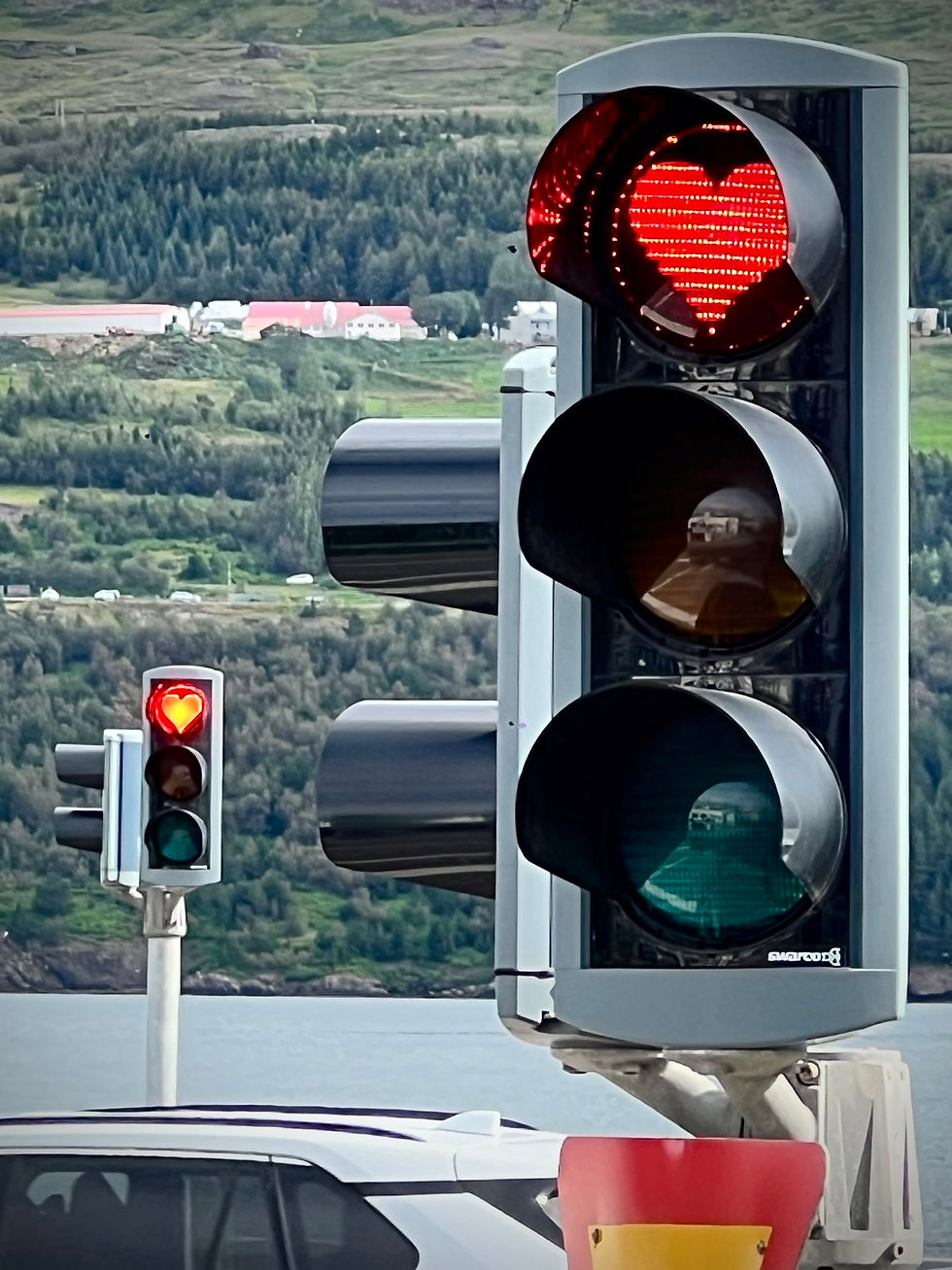
During the day Nick got himself a new girlfriend......
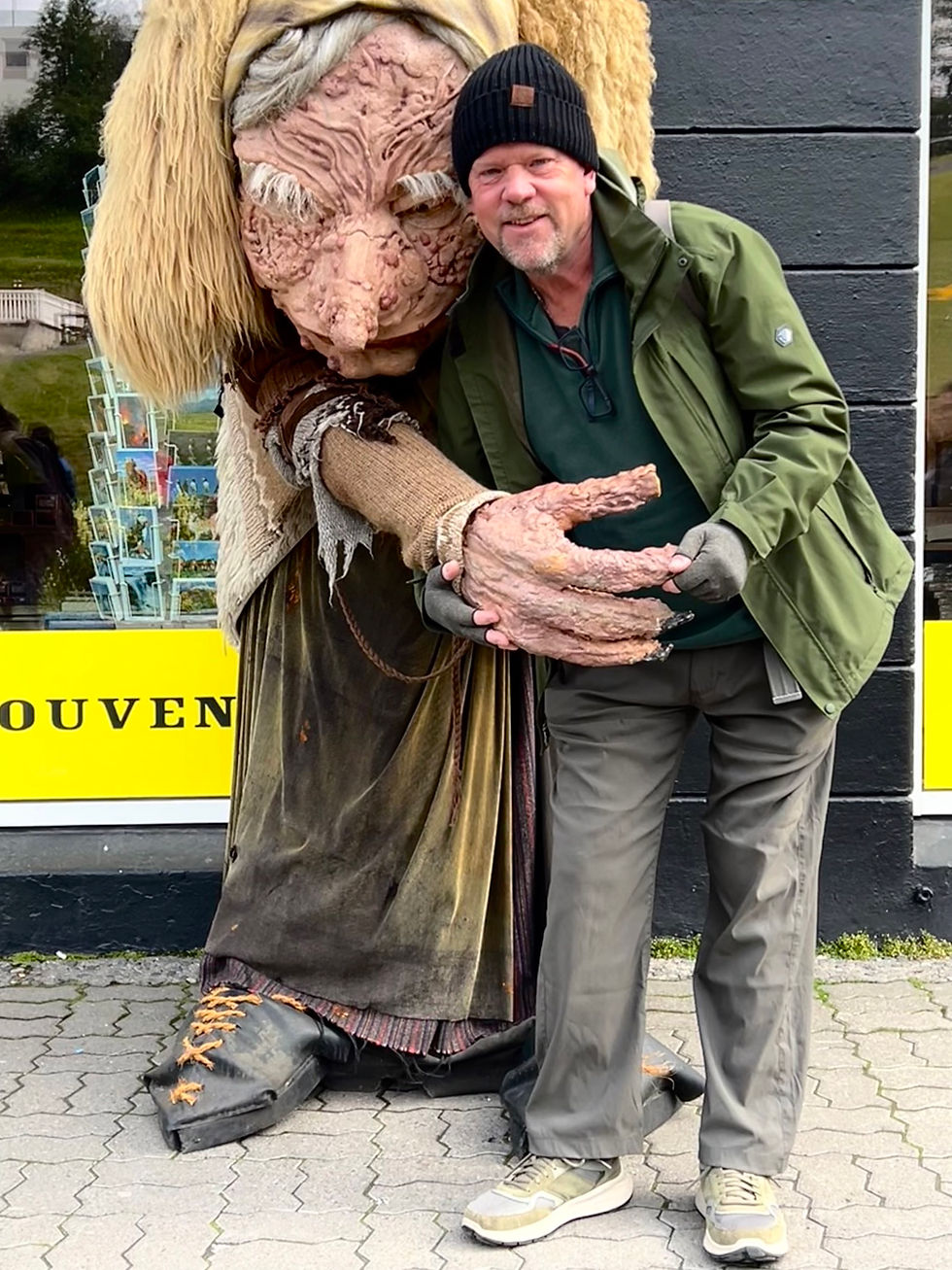
.....and Janette went berserk kitting herself out in a fetching outfit that will hopefully prevent her from ever getting wet again!
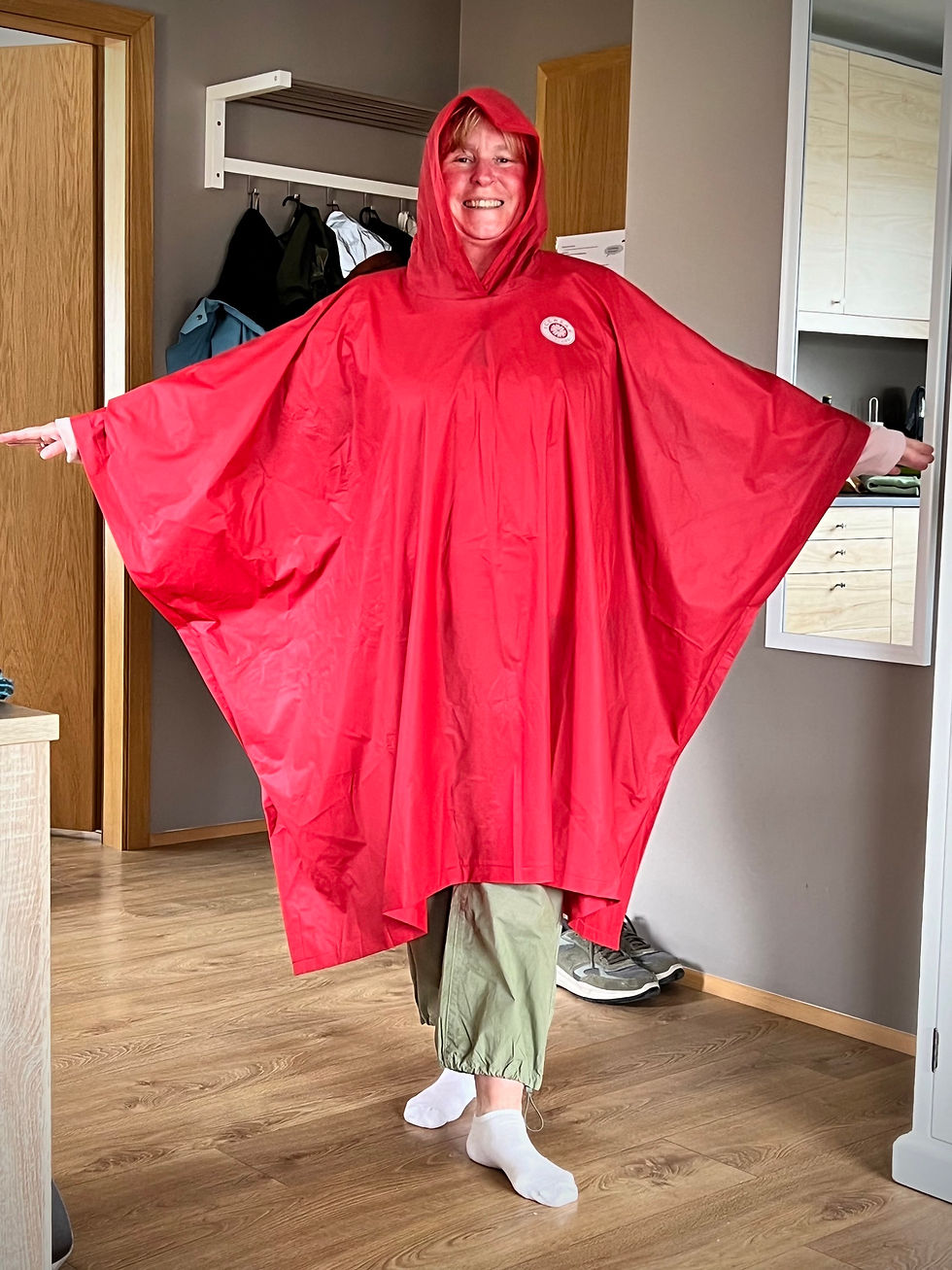
Onwards and upwards as we return to Rocky tommorow for the next leg of our adventure.....join us next week.



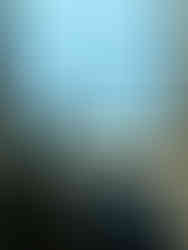






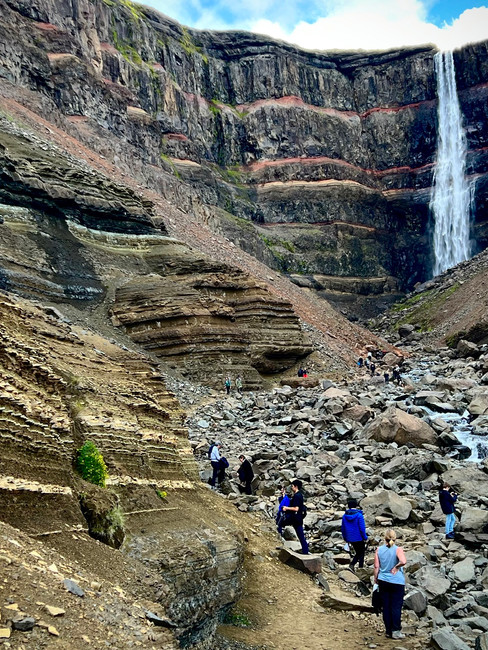
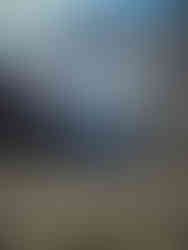









The waterfalls are amazing what a wonderful adventure . The houses look a lot like Norway and we also found that knitting was a big thing there too . Thanks for sharing such lovely photos.
Wow - what a fantastic trip. Look forward to the next instalment. 😊
Breathtaking views 😎, looks very cold, glad you got your thermals!!! Happy camping. 🤗🤗
Wow just caught up on your blog 🥂🥂